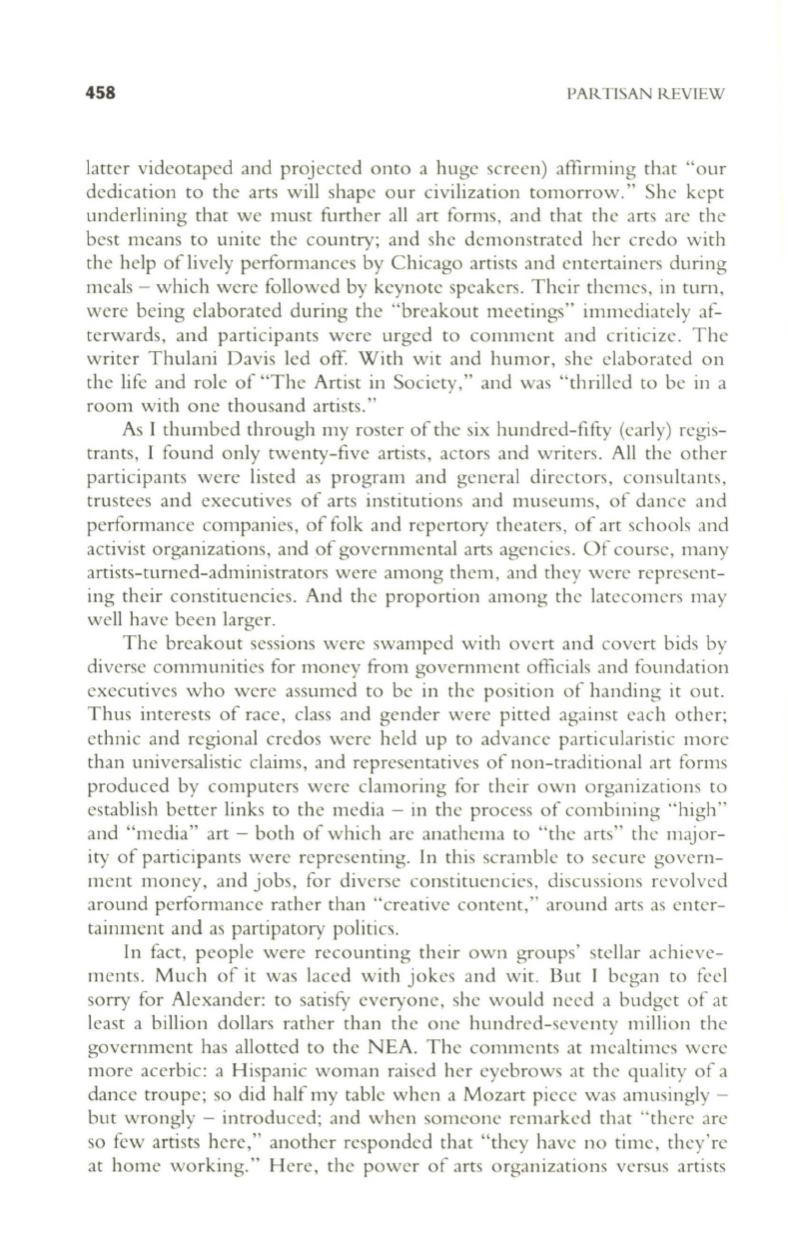
458
PARTISAN REVIEW
latter videotaped and projected onto a huge screen) affirming that "our
dedication to the arts will shape our civilization tomorrow." She kept
underlining that we must further all art forms, and that the arts are the
best means to unite the country; and she demonstrated her credo with
the help of lively performances by Chicago artists and entertainers during
meals - which were followed by keynote speakers. Their themes, in turn,
were being elaborated during the "breakout meetings" immediately af–
terwards, and participants were urged to comment and criticize. The
writer Thulani Davis led off. With wit and humor, she elaborated on
the life and role of "The Artist in Society," and was "thrilled to be in a
room with one thousand artists."
As I thumbed through my roster of the six hundred-ftfty (early) regis–
trants, I found only twenty-five artists, actors and writers. All the other
participants were listed as program and general directors, consultants,
trustees and executives of arts institutions and museums, of dance and
performance companies, of folk and repertory theaters, of art schools and
activist organizations, and of governmental arts agencies. Of course, many
artists-turned-administrators were among them, and they were represent–
ing their constituencies. And the proportion among the latecomers may
well have been larger.
The breakout sessions were swamped with overt and covert bids by
diverse communities for money from government officials and foundation
executives who were assumed to be in the position of handing it out.
Thus interests of race, class and gender were pitted against each other;
ethnic and regional credos were held up to advance particularistic more
than universalistic claims, and representatives of non-tradi tional art forms
produced by computers were clamoring for their own organizations to
establish better links to the media - in the process of combining "high"
and "media" art - both of which are anathema to "the arts" the major–
ity of participants were representing.
In
this scramble to secure govern–
ment money, and jobs, for diverse constituencies, discussions revolved
around performance rather than "creative content," around arts as enter–
tainment and as partipatory politics.
In
fact, people were recounting their own groups' stellar achieve–
ments. Much of it was laced with jokes and wit. But I began to feel
sorry for Alexander: to satisfy everyone, she would need a budget of at
least a billion dollars rather than the one hundred-seventy million the
government has allotted to the NEA. The comments at mealtimes were
more acerbic: a Hispanic woman raised her eyebrows at the quality of a
dance troupe; so did half my table when a Mozart piece was amusingly -
but wrongly - introduced; and when someone remarked that "there are
so few artists here," another responded that "they have no time , they're
at home working." Here, the power of arts organizations versus artists


